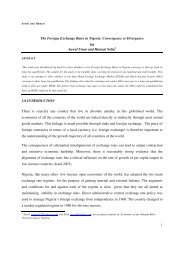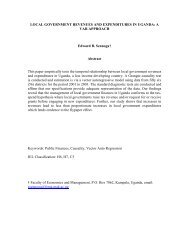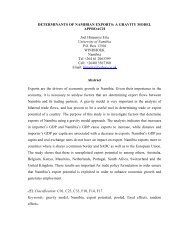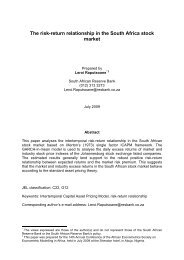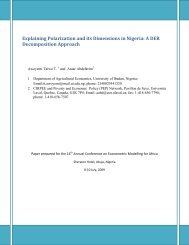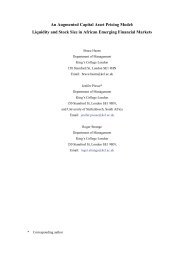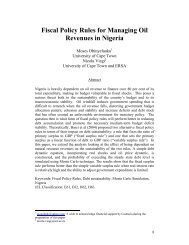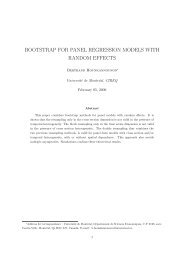Dynamic Effects of Monetary Policy Shocks in Malawi* - African ...
Dynamic Effects of Monetary Policy Shocks in Malawi* - African ...
Dynamic Effects of Monetary Policy Shocks in Malawi* - African ...
Create successful ePaper yourself
Turn your PDF publications into a flip-book with our unique Google optimized e-Paper software.
Selection <strong>of</strong> the optimal lag length is guided by established criteria 1 . Akaike and Hannan-Qu<strong>in</strong>nInformation Criteria (AIC and HIC, respectively) suggest a lag length <strong>of</strong> order 42 whileSchwartz Information Criterion (SIC) suggests a lag length <strong>of</strong> order two. The problem with theformer is that it uses up all degrees <strong>of</strong> freedom and renders the estimated VAR unstable with 83<strong>in</strong>verse roots <strong>of</strong> the characteristic autoregressive (AR) polynomial ly<strong>in</strong>g outside the unit circle.The latter, on the other hand, performs well <strong>in</strong> a robustness check and it is adopted. At thechosen lag length (<strong>of</strong> order two), all the eight <strong>in</strong>verse roots <strong>of</strong> the characteristic AR polynomialhave modulus less than one and lie <strong>in</strong>side the unit circle, <strong>in</strong>dicat<strong>in</strong>g that the estimated VAR isstationary or stable (see Table C1 <strong>in</strong> Appendix C). A VAR lag exclusion Wald test also revealsthat all endogenous variables <strong>in</strong> the model are jo<strong>in</strong>tly significant at each lag length for allequations collectively. Separately, all equations are significant at lag length <strong>of</strong> order one while atlag length <strong>of</strong> order two, only consumer price and output equations are <strong>in</strong>significant (see Table C2<strong>in</strong> Appendix C). S<strong>in</strong>ce the SIC imposes a harsher penalty for add<strong>in</strong>g more regressors than AIC,the criterion is deemed more appropriate for determ<strong>in</strong><strong>in</strong>g lag length <strong>in</strong> a VAR.Departures from established criteria for the determ<strong>in</strong>ation <strong>of</strong> optimal lag length are notuncommon <strong>in</strong> the literature. Piffanelli (2001) argued that 12 lags are appropriate with monthlydata to avoid seasonality problems. She, however, <strong>in</strong>cluded six lags <strong>in</strong> a study <strong>of</strong> Germanywithout rationalisation. Becklelmans (2005) used a lag length <strong>of</strong> order three <strong>in</strong> a study <strong>of</strong>Australia „because it provides reasonable dynamics without shorten<strong>in</strong>g the estimation sample toomuch.‟ Vonnak (2005) used three lags <strong>in</strong> a study <strong>of</strong> Hungary „because they were enough toproduce uncorrelated residuals, based on the evidence <strong>of</strong> the multivariate-LM test.‟ Us<strong>in</strong>gquarterly data <strong>in</strong> a study <strong>of</strong> Thailand, Disyatat and Vongs<strong>in</strong>sirikul (2003) settled for two lagswhile the optimal lag length under various criteria appeared to be one because they felt onequarter is too short a period to capture the dynamics <strong>of</strong> a system. This study, however, f<strong>in</strong>ds tojustification to depart from the established criteria.Before mak<strong>in</strong>g <strong>in</strong>ferences on the structural shocks <strong>in</strong> the model, we analyse correlations betweenmovements <strong>in</strong> the bank rate and reserve money and their correspond<strong>in</strong>g recovered structuralshocks to ascerta<strong>in</strong> if the monetary policy shocks are reasonable. Figures 4.1 and 4.2 presentplots <strong>of</strong> recovered bank rate and reserve money structural <strong>in</strong>novations aga<strong>in</strong>st month-on-monthgrowth rates <strong>of</strong> the bank rate and the logarithm <strong>of</strong> reserve money, respectively, with therecovered structural shocks plotted on the primary vertical axis and the monetary policyoperat<strong>in</strong>g targets on the secondary vertical axis. Positive structural <strong>in</strong>novations <strong>of</strong> the bank rateand negative structural <strong>in</strong>novations <strong>of</strong> reserve money are associated with monetary policytighten<strong>in</strong>g while negative structural <strong>in</strong>novations <strong>of</strong> the bank rate and positive structural<strong>in</strong>novations <strong>of</strong> reserve money are associated with monetary policy loosen<strong>in</strong>g.The charts reveal that there is some correlation <strong>in</strong> the movements <strong>of</strong> the monetary policyoperat<strong>in</strong>g targets and their respective recovered <strong>in</strong>novations. The correlations are, however, morepronounced between the bank rate and its recovered structural shocks compared to reservemoney and its recovered structural shocks. Reliability <strong>of</strong> the structural shocks is also ascerta<strong>in</strong>edby assess<strong>in</strong>g the efficiency <strong>of</strong> the structural coefficients estimated <strong>in</strong> the SVAR. Table C3 <strong>in</strong>1 This approach is applied <strong>in</strong> all subsequent models.15 | P a g e



